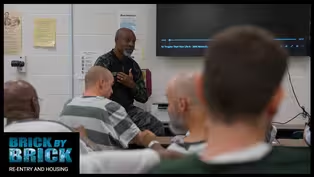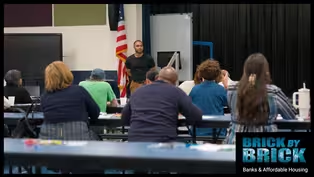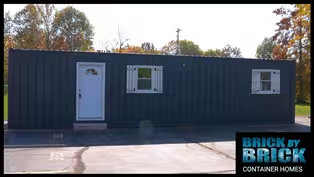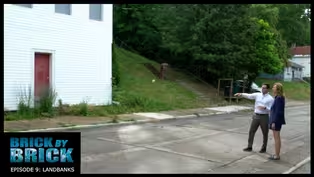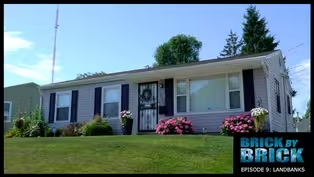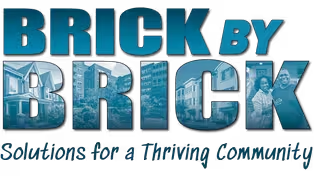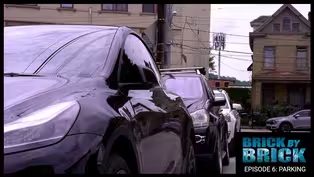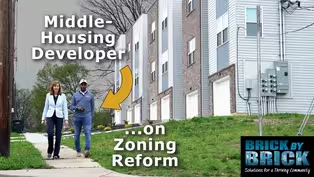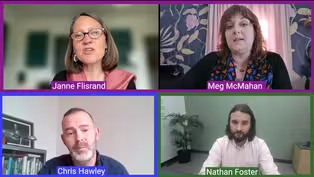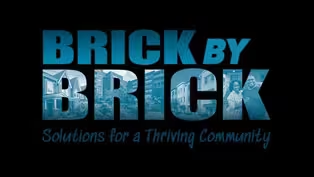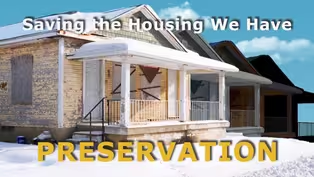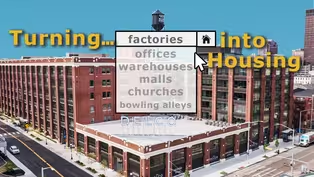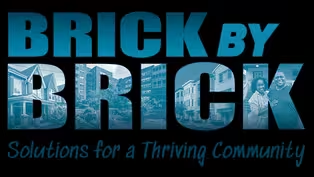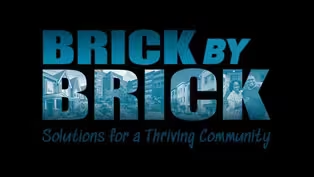
Adaptive Reuse: The Barrister offers Affordable Housing
Clip: Season 1 | 9mVideo has Closed Captions
OTRCH and Urban Sites turn an office building into affordable apartments in Cincinnati.
In the heart of Cincinnati's Central Business District, Over-the-Rhine Community Housing and Urban Sites transform the historic Barrister buildings into the first affordable housing apartments in the area in nearly three decades. Brick by Brick took a tour of the area and met one of the new residents, as we investigate adaptive reuse as a housing solution.
Problems playing video? | Closed Captioning Feedback
Problems playing video? | Closed Captioning Feedback
Brick by Brick is a local public television program presented by CET

Adaptive Reuse: The Barrister offers Affordable Housing
Clip: Season 1 | 9mVideo has Closed Captions
In the heart of Cincinnati's Central Business District, Over-the-Rhine Community Housing and Urban Sites transform the historic Barrister buildings into the first affordable housing apartments in the area in nearly three decades. Brick by Brick took a tour of the area and met one of the new residents, as we investigate adaptive reuse as a housing solution.
Problems playing video? | Closed Captioning Feedback
How to Watch Brick by Brick
Brick by Brick is available to stream on pbs.org and the free PBS App, available on iPhone, Apple TV, Android TV, Android smartphones, Amazon Fire TV, Amazon Fire Tablet, Roku, Samsung Smart TV, and Vizio.
Providing Support for PBS.org
Learn Moreabout PBS online sponsorship- Hello, I'm Hernz Laguerre Jr. for Brick by Brick.
Developers tell me that affordable housing isn't affordable to make.
The finances still have to make sense, causing them to find creative ways to fill gaps in funding.
We see this with a new development in downtown Cincinnati called The Barrister.
Over-the-Rhine Community Housing, a nonprofit organization and property management company Urban Sites joined forces to adapt an old office building into the first affordable housing within the central business district in more than two decades.
I visited the new development to see how they pulled it off.
Take a look.
- Todd Halsell: If I told you I was paying $2,500 a month for this, it is believable, isn't it?
You know what I mean?
Like, and it doesn't cost me $2,000 a month.
- 54-year-old Todd Halsell just moved into the Barrister Apartments.
Built in the 1800s, the Barrister buildings served a variety of manufacturing purposes, such as a shoe factory, production of printing presses, and eventually it turned into some office spaces.
Now in the heart of Cincinnati's Central Business District, the Barrister is one of the most recent examples of adaptive reuse.
The historic office building is being turned into affordable apartments with rents ranging from as low as $400 a month to $1,400 a month.
With steady employment as a plumber, Todd is able to afford the monthly rent of $900 a month, which is well below the market rate.
- Ben Eilerman: Central business district for a long time was really a a, a dawn to dusk area.
As we're seeing the revitalization from Over-the-Rhine move in, we're seeing more residents move down here too.
So as the popularity and the amenities down here grow, the rent has also grown.
- Ben Elierman, director of real estate development at Over-the-Rhine Community Housing gave us a tour of the two historic buildings that make up the Barrister.
What makes the Barrister unique is that it offers apartments at 30 to 60% of the area median income, making it the first affordable housing project in the downtown area in more than three decades, which is one of the reasons why Todd is grateful to be a new resident.
- Halsell: Yeah, I've done it all, you know, on both sides of the fence.
From the hood to the Hollywood, from the block to the boardroom, you know.
Hernz: Todd was born and raised in Cincinnati, but as he became an adult, different jobs took him to Indianapolis, Atlanta, and even further out west in California.
But there's no place like home.
- Halsell: I just wanted to be, you know, in my city and my have a place in my own name.
- Hernz: But Todd had difficulties passing background checks.
- Halsell: 'cause I did prison time for, you know, drug charges.
And once you get that sticker, nobody wanted to rent to me no matter if you got money or a job or anything.
- Hernz: So Todd's housing situation was unstable until he crossed paths with the David and Rebecca Barron Center for Men.
It's a shelter house for homeless men in Cincinnati.
- And I went to the drop-in the second time and that is when it changed because I changed my mind state.
- Hernz: Michelle Christopher is a case worker at Over-The-Rhine Community Housing where she worked with Todd.
- Christopher: When I first met Todd, he was well spoken, well groomed.
I thought maybe he came here to work or something.
You wouldn't think he came from the homeless population.
- Hernz: As Michelle and Todd kept speaking, Michelle heard someone that needed help.
- Christopher: He needs help in getting his life on the right track - Hernz: Over-the-Rhine Community Housing believes that every right track begins with housing.
- Christopher: That means putting them in housing first and working on their barriers - Hernz: Over-the-Rhine Community Housing had to overcome some barriers of their own to make this project possible.
- Eilerman: Projects like this are expensive and they're made more difficult by the fact that when we charge affordable rents, that we don't have as much money to pay off debt like a traditional project would.
So of about a 16 and a half million dollars project, we had to go after all kinds of sources - Hernz: To get the money they needed Over-the-Rhine Community Housing alongside developer Urban Sites enlisted low-income housing tax credits, historic tax credits, and philanthropic donations, all of which were necessary.
- Eilerman: Buildings like these are hard.
There's many challenges that are here.
And so the historic tax credits help to offset some of those costs.
And, and most importantly, the low-income housing tax credits make it viable for us to charge affordable rents here.
This project wouldn't have happened without it.
- Hernz: LISC, which stands for Local Initiative Support Corporation, was one of the projects partners.
Executive director Kristen Baker says the barrister is a great example of a for-profit developer and a nonprofit working together - Over the Ryan Community Housing.
They are a nonprofit entity, right?
And so sometimes they maybe are not always able to draw down the capital resources that are required to do large multimillion dollar housing projects.
And you can combine the power of a of a for-profit developer who really brings a lot of expertise and you can bring in that affordable housing expertise and development experience from a non-profit, affordable housing developer.
It's really a great partnership.
- Eilerman: We're fortunate to have partnered with LISC here locally and nationally to provide us a, a really attractive and competitive permanent debt on the project.
- And with that low rate, it meant that they could borrow so that they could get over the hurdles and have this project cross the finish line.
And there are many hurdles.
- Baker: So development is not for the faint of heart.
In the case of projects like the barrister, which are incredibly complex with lots of different public financing tools involved, that requires a lot of different inspections.
- Hernz: Since the Barrister is designated as a historic building, they had to adhere to some requirements.
Eilerman: So the historic folks said that we could not, we cannot build this wall out any thicker.
Sometimes when we can, we'll build the wall out thicker and put insulation in here.
The historic folks, number one said that that's something that we couldn't do.
- Hernz: Or there were supply chain issues.
- Eilerman: A $60 electric breaker can hold up the occupancy and the completion of a building.
This went six to eight months at the cost of hundreds of thousands of dollars.
- Hernz: Wait, what a piece that cost $60 cost a project, hundreds of thousands of dollars?
How does that make sense?
- Eilerman: And that is where it's, it's been just so, so difficult, so frustrating to work in the, in the current environment we're in.
- (APPLAUSE) Hernz: But the hurdles are cleared at the standing room only.
ribbon cutting on March 7th, 2024, Mayor Aftab Pureval highlighted the significance of affordable housing in the downtown area.
- Projects like the Barristers that that don't just happen, especially when it comes to truly affordable housing, helping to grow our city into a more vibrant community for not just some of us, but for all of us.
Christopher: It's not easy.
Living down here is expensive.
That's why some feel like they won a lottery and it's based on their income.
I think it'd work out fine for Todd 'cause he's trying to build a a life and stay on that path.
- Halsell: And I was always wanting an apartment right down here from when I would be in trouble here at the Justice Center, or even when I was in the drop-in center.
I'm like, downtown is really coming up and I got blessed.
- Hernz: So as you saw on the piece, development is not for the faint of heart e, especially affordable housing.
But one thing I want to point out though is the funding.
We heard Ben Eilerman say that he needed state subsidies and federal subsidies in order to make the Barrister work.
Without both of them, the Barrister just wouldn't have happened.
But state lawmakers have recently changed the rules so that you can't use state subsidies and federal subsidies together.
You can't combine them, which makes the Barrister a one of one.
The Barrister is also held up as an example of public and private partnership working together in order to create affordable housing.
So maybe the Barrister might be held up as an example as a reason for state lawmakers to revisit those rules.
Something that we'll keep an eye on for Brick by Brick, I'm Hernz Laguerre Jr.
Can land trusts help provide affordable housing?
Video has Closed Captions
Clip: S1 | 6m 20s | Groups in Yellow Springs & Cincinnati, Ohio, use land trusts to make homes affordable. (6m 20s)
Is there a pathway to housing for the formerly incarcerated?
Video has Closed Captions
Clip: S1 | 6m 19s | A successful reentry into society depends on stable housing. (6m 19s)
Is Homeownership Right for Me?
Video has Closed Captions
Clip: S1 | 5m 44s | Banks & other organizations help Dayton residents figure out a path to homeownership. (5m 44s)
Container Homes: A Possible Solution for Affordable Housing
Video has Closed Captions
Clip: S1 | 4m 32s | Shipping containers are being transformed to provide housing. Can they be affordable? (4m 32s)
The Port's restoration process in Sedamsville is Underway
Video has Closed Captions
Clip: S1 | 3m 49s | Vice President of the Port gives us a walkthrough of the rehabbed homes in Sedamsville. (3m 49s)
The Montgomery Landbank Revitalizes homes in Pineview
Video has Closed Captions
Clip: S1 | 4m 15s | The Montgomery County Landbank helps stabilize the housing market with work in Pineview. (4m 15s)
A Housing Solution Right in our Backyard
Video has Closed Captions
Clip: S1 | 6m 34s | Two Cincinnati residents share their experience building an accessory dwelling unit. (6m 34s)
How Reducing Parking Minimums could Maximize the Opportunity
Video has Closed Captions
Clip: S1 | 7m 55s | Camp Washington navigates their paring and provides a test case for Cincinnati. (7m 55s)
Right to Counsel: Balancing the Courtroom
Video has Closed Captions
Clip: S1 | 8m 25s | A Dayton tenant details her experiences facing eviction with and without an attorney. (8m 25s)
Middle Housing Developer... on Cincinnati's Zoning Reforms
Video has Closed Captions
Clip: S1 | 4m 6s | As Cincinnati looks to change its zoning laws, one middle housing developer shows support. (4m 6s)
Zoning Reform Addressing the Invisible Barriers in the U.S.
Video has Closed Captions
Clip: S1 | 9m 16s | City planners from Tulsa, Buffalo, & Minneapolis detail their cities' zoning reform. (9m 16s)
Adaptive Reuse: The Barrister offers Affordable Housing
Video has Closed Captions
Clip: S1 | 9m | OTRCH and Urban Sites turn an office building into affordable apartments in Cincinnati. (9m)
Adaptive Reuse: The Grant Deneau Tower
Video has Closed Captions
Clip: S1 | 6m 32s | The Windsor Companies turns a mid-century modern office building into luxury apartments. (6m 32s)
Affordable Housing Solution: The Port's Approach
Video has Closed Captions
Clip: S1 | 10m 6s | A married couple and an army vet share their journey to finding affordable homeownership. (10m 6s)
Promo: Container Homes Solution
Video has Closed Captions
Preview: S1 Ep6 | 25s | They've been used for shipping, but can industrial containers also be a housing solution? (25s)
Video has Closed Captions
Preview: S1 Ep5 | 30s | Preview for the Brick by Brick team's upcoming episode on preservation in housing. (30s)
Video has Closed Captions
Preview: S1 Ep4 | 25s | Southwest Ohio is a leader in upcycling its buildings. Housing solution: adaptive reuse. (25s)
Promo: Housing Choice Vouchers Re-Examined (Promo)
Video has Closed Captions
Preview: S1 Ep2 | 30s | Re-examining the largest federal rental assistance solution. How well is it working? (30s)
Promo: Housing & Data Analytics (promo)
Video has Closed Captions
Preview: S1 Ep1 | 30s | The Brick by Brick team explores a new housing solution: preventative data analytics. (30s)
Providing Support for PBS.org
Learn Moreabout PBS online sponsorship
- News and Public Affairs

Top journalists deliver compelling original analysis of the hour's headlines.

- News and Public Affairs

FRONTLINE is investigative journalism that questions, explains and changes our world.
Urban Consulate Presents











Support for PBS provided by:
Brick by Brick is a local public television program presented by CET

